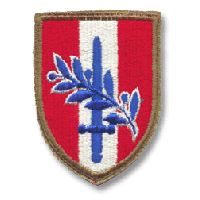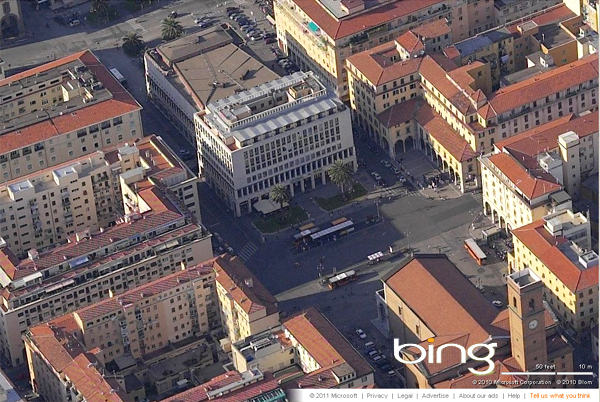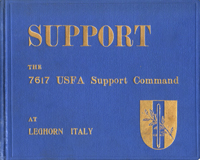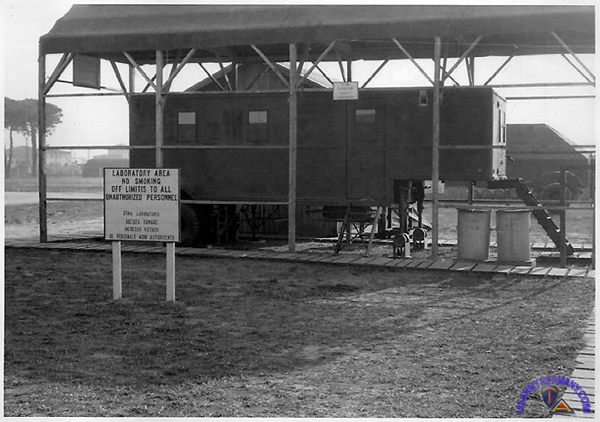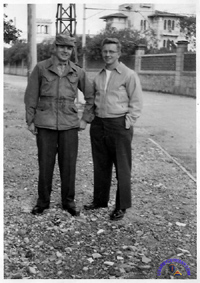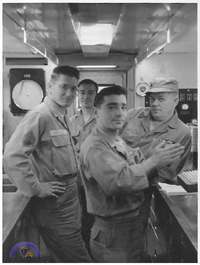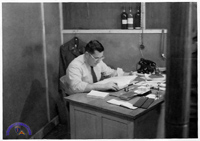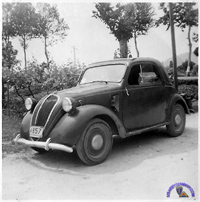| If you do NOT see the Table of Contents frame to the left of this page, then Click here to open 'USArmyGermany' frameset |
||||||||||||||||
USFA Support Command |
||||||||||||||||
|
|
||||||||||||||||
|
||||||||||||||||
|
|
||||||||||||||||
| 7617 USFA Support Command | ||||||||||||||||
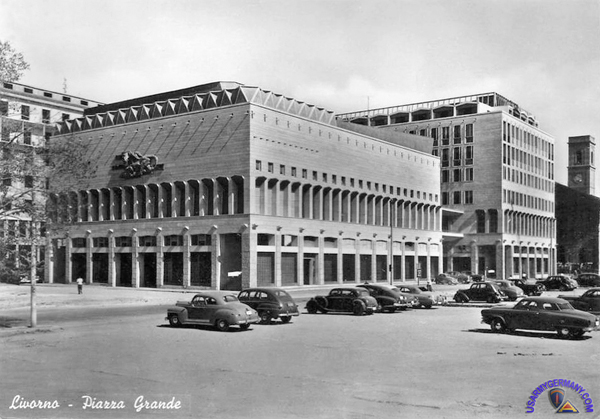 HQ USFA Support Command until Sept 1954 - Palazzo Grande (Italian postcard) |
||||||||||||||||
| (Source: A picture story of the 7617 USFA Support Command at Leghorn, Italy) | ||||||||||||||||
|
||||||||||||||||
| Three military organizations of the U. S. Army function here in Leghorn: The 9th Medium Port is charged with the responsibility of receiving by ocean freight both material and personnel. The 7689 USFA General Depot is charged with the responsibility of storing and disbursing vehicles, material and other equipment once it is received from the States by the Port. The 7617 USFA Post is a normal army function and has the responsabilities that are generally given to an army post anywhere in the world. Since the opening of the port more than 346,170 tons of materials have moved into Austria by truck and rail over the historical Brenner Pass. Head of the receiving and unloading of this cargo is Colonel Frederick W Hyde, who commands the 9th Medium Port. Hyde is an old hand at Port work and has more than thirty-five years experience as a transportation officer, quartermaster and infantryman. He assumed command of the Port on July 15, 1952 after being Chief of the Wyoming Military District. During a previous tour in Austria he was with the C-4 Section. Hyde is a native of Wyoming, and when he finally decides to retire, he says that he will devote his time to hunting and fishing. Taking over from Colonel Hyde's activities is the Commanding Officer of the 7689 Hdqs USFA General Depot, Colonel Robert W. Marvin. Colonel Marvin opened the Depot after having been assigned to the 7602nd Storage Depot at Innsbruck from December 1949. Marvin, an organizer and pusher, gets the job done with a minimum of effort. Right at the moment his office luxurious to the point that he now has a desk, instead of the crate he used for weeks while hurrying the completion of the depot, overlooks a mass of activity. Bulldozers and graders move methodically back and forth to level the outside storage area. Electricians lay underground conducts to supply the electricity for the Depot Area. Row after row of jeeps, trucks, trailers and tanks await shipment to outside points. Stored on platforms to prevent spoilage of water, the terrain is quite low, are hundreds of covered stock piles of material. As we watched out of the office window, a couple of Carabinieri on horse back rode by on patrol. Two others followed in the distance on bycicle. This same big burly Colonel with 35 years of service for pay purposes is one of the leading authorities in the States on tropical fishes. He talks between drags on a curved pipe with an affection for his depot as a small boy who admires and loves a big brother, who is a problem but still something that he loves. From the depot the material and equipment come to the hands of the 7617 USFA Post Transportation Section. The Transportation Section Chief is Lt Col George M. McClintic who formerly commanded the 9th Medium Port Leghorn. Col McClintic supervises the actual transportation of materials and equipment. Backing the knowledge that he must possess to do this tremendous job are many years of port work at New York, Boston, and Savannah, to say nothing of being Assistant Transportation Officer for the world famous Berlin airlift. The Section consists of the Rail Branch and the Highway Branch. The mission of the rail branch is to coordinate movements along the line of communication between Italy and Austria; to coordinate rail movements between Leghorn and Rome in connection with the Vehicles Rebuild Program; and to coordinate all special rail passenger movements of troops and dependents arriving at or departing from the Leghorn Port of Embarkation. The Rail Branch operates RTOs at Brenner, Verona, Calambrone, Livorno Centrale, Tombolo, Pistoia, Florence and Rome. The last three RTOs are established for the purpose of loading, shipping, receiving and unloading vehicles in connection with the World War II Vehicle Rebuild Program. The Rail Branch is concerned with the operation of the Leghorn-Salzburg Sleeper and the Leghorn-Salzburg weekly baggage car. Major Robert J. Yunker is Chief of the Rail Branch. Motor Transportation activities are coordinated and supervised by Major Michael S. DeAngelis, Chief of the Highway Branch. The 8th Trans Heavy Truck Company, commanded by Captain Eugene B. Hotz, operates the Consolidated Motor Pool; and the 640th Transportation Heavy Truck Company, commanded by Captain Melvin M. Wolfe, performs special motor transportation missions and operates convoy movements between Austria and Italy. Convoys to Pistoia and Florence run five days weekly transporting World War II Vehicles. A total of 375 vehicles and 250 cargo trailers, averaging 365,000 miles per month, are utilized in providing motor service. The accident rate of the motor transportation agencies is one of the lowest in USFA. Ten scheduled bus routes are in effect; and there are additionally three commissary bus routes and three recreational bus routes from Camp Darby. Today hundred of trucks, jeeps, tanks and other vehicles line stowage area at Camp Darby on Italy's famous number one highway. Camp Darby has replaced the infamous Tombolo area of black market fame following Word War II. The third man in the theme of the Leghorn operation is Colonel John L. Pauley, Jr., of Chippewa Falls, Wisconsin. Pauley, a very young executive, a graduate of the U. S. Military Academy at West Point, assumed command of the 7617 USFA Post in December 1952. Pauley, an executive of proven ability, assumed the command of the Linz Military Post after having been Deputy Comptroller of USFA for eighteen months, before becoming C. O. of the 7617 USFA Post. When the Leghorn activity was first opened, the work of reconstructing such things as warehouses, docks, storage areas, offices and living quarters had to begin from the ground up. The work was begun under Colonel Norman H. Vissering of Babson Park, Florida. Of chief concern at first was the fact that only those ships which drew little water could navigate the channel to the dock. Through constant work on the part of the Engineers this channel is now clean and two cargo ships may be docked at the same time. Labor difficulties have been very few. A special section was organized to operate the port. With steady work and higher wages applicants were numerous. Except for the usual few hours that are devoted to work stoppages spasmodically no labor problems have presented themselves. Housing for instance is one of the main hardships in Leghorn, since no government quarters are available and the private rental agreements must be negotiated at the offices of the local Prefect. Soldiers with dependents rent their houses from individual Italian owners and supply their own utilities from the Italian economy. So far as the soldiers are concerned without dependents, the majority of them are now housed in newly built concrete and stucco barracks, at Camp Darby, which in the next few months will be the hub and center of all the activities in Leghorn. Ten warehouses are now completed for the storage of materials and these warehouses contain more than 70,000 items necessary to operate the United States Forces in Austria. Moving rapidly on construction, the Camp Darby Area will have, upon completion, theaters, a chapel, bachelor officers quarters, a recreation hall, the headquarters for the 7617 USFA Post, a school for dependent children, and a training building. The present headquarters is located in downtown Leghorn in a marble, stone building which was originally intended to be an apartment house. This building the soldiers refer to as the "marble palace". Speaking of soldiers - what do they think of this set up in a sovereign country where they are subject to the laws of the Republic of Italy and where MPs are not armed, but are constantly in the company of more than two hundred carabinieri? This Company of Carabinieri stationed in Leghorn for the sole purpose of Police work for the Americans living and working there. The same soldiers that you'll find in France, Germany or anywhere else in the world are located in Leghorn. He does the same job, he drives a truck, he works in an office, he supervises the unloading cargo or the building of roads. He has the same gripes and the same pleasures. He eats pizza and spaghetti and goes to places that formally have been only a name in a geography book, such as Rome, Naples, Venice, and other historical cities. He goes to the P.X., especially around pay days, and to the Snack Bar, eats banana-splits, wears civilian clothes when he has a date with a young lady of his choice. He goes to the American movies or to the NCO or Enlisted Men's Club. He drinks wine cautiously, preferring coca-cola and beer which he has become, accustomed to after being in Austria or Germany. He has a chance to see his fellow soldiers, the WACs doing an efficient job of operating the administrative work, handling dependents arriving in Leghorn or USFA, scheduling and reserving space in the military train which runs six days a week from Leghorn to Salzburg. He sees the same WACs assisting in the operation of the Commissary or the Photographic Lab, or the Signal switchboards. To the average soldier in Leghorn, the picture is not different from any other station overseas. He learns enough Italian to order a meal or to talk to his Italian friends. He learns to appreciate Italian arts and on the weekend, he arms himself with his camera for visits to the various and sundry historical places of interest. Department of the Army Civilians come in for their fair share of praise in the operation of this unique command. They're scattered throughout the Command as engineers, personnel people, stenographers, clerks, typists, port personnel, safety and all other positions one normally finds in a big business. The operation at Leghorn is a big business and with all of the handicap of operating the Post, Colonel Pauley's operation is considered to be the cheapest for the taxpayer of any in the overseas command today. For instance: the cost of construction is approximately 75% below that in France. American building contractors are at first horrified to see that the contractor work shacks are built of brick or stone, knowing full well that they ought to be merely temporary structures, but when one stops to consider the cost of wood, it is much cheaper to build out of stone or marble and the permanency of course is vastly greater. In building the same warehouse or headquarters building or any other building for that matter, less than ¼ of the total amount of steel is used by the Italian construction methods, as would be used by state side methods. This does much to lessen the cost and to keep the 7617 USFA Post operating as one of the least costly operations in the Army today. |
||||||||||||||||
| 1954 | ||||||||||||||||
| (Source: USFA SENTINEL, Sept 3, 1954) | ||||||||||||||||
| Annual savings of more than $156,000 have been affected through the release of American-rented Italian property, Support Cmd revealed last week. A large construction program, which is nearing completion, will provide facilities in Camp Darby for military establishments previously scattered throughout the city of Leghorn. As a result of the consolidation of these military establishments, three small manufacturing areas and six large buildings have been released. Rental holdings released during the period February 1 through May 1, 1954, provided an annual savings of more than $110,000. The return of the Metallurgical Plant, which housed the provost marshal and the post engineer, realized a savings of $41,000, while the release of the Corallo Hotel, which previously was occupied by the 7693 WAC Det, netted an annual saving of $53,000. The remainder of the $156,000 saving was realized with the release of the former motor pool area, dependents school, and the Moto Fides area. |
||||||||||||||||
| (Source: STARS & STRIPES, October 10, 1954) | ||||||||||||||||
| Headquarters of the 7617 USFA Support Command has moved from the Palazzo Grande in Livorno to Camp Darby, eight miles north of the city. The EES snack bar and the PX located in the former headquarters building have been closed. |
||||||||||||||||
| 1955 | ||||||||||||||||
| (Source: STARS & STRIPES, Oct 31, 1955) | ||||||||||||||||
| The USFA Support Comd marked the end of its four year stint as a logistical base for the U.S. Forces in Austria in a simple ceremony of redesignation as the Southern European Task Force Support Comd that was held at Camp Darby, Leghorn.
Col Charles L. Williams is the commanding officer of the new SETAF Support Comd. Col Charles L. Williams, SETAF Support Comd CO, touched the NATO flag presented to him by Lt Col Stanislaw Niec, command adjutant, as a token of acceptance just before it was hoisted aloft with the U.S. and Italian flags. Nearly 1,000 troops and spectators stood quietly as the general order redesignating the command was read. An honor guard composed of platoons from the 68th MP Co, Camp Darby, the Nucleo Carabinieri and the Camp Darby Drum and Bugle Corps rendered appropriate honors. The troops who witnessed the ceremony were members of the 7617th Hq and Sv Co, 7675th Hq Co, the 21st Sig Co, the 409th AAA Btry (?), and the 68th MP Co. |
||||||||||||||||
| USFA General Depot | ||||||||||||||||
| 1954 | ||||||||||||||||
| (Source: STARS & STRIPES, June 4, 1954) | ||||||||||||||||
| The building program for the USFA General Depot, which stretches about 1 mile along the Leghorn-Pisa highway adjacent to Camp Darby, Italy, began in July 1951 and is nearing completion (October). (The depot is about 7 miles from the port.) The depot supports the flow of supplies for USFA in Austria. CO of the depot is Lt Col John F. Stein; he reports to the commander of USFA Support Command, Col John C. Person. Construction has been supervised by the 7615th Engr Const Detachment. Backbone of the depot are 12 new warehouses, each covering an acre. (The first warehouse was completed in July 1952.) Rows of tanks, trucks and jeeps line the area and crated material covered by canvas is stored outside between the warehouses. There are about 5,000 vehicles in storage at the depot. Cargo arrives at the Port of Leghorn by ship where it is unloaded and transported to the depot by rail and truck. Some of the supplies are stored at the depot and some of it is reshipped to US forces in Austria. The depot has a staff of 60 officers, 23 DA civilians, 250 enlisted men and 1,000 Italian civilians and handles approx. 200,000 line items. Class III - Thousands of 5-gallon gasoline cans are rejuvenated annually at the depot. They are used to resupply POL dumps in Austria. Also, the depot is home station for teams that test stored gasoline along the 500-mile supply line between Leghorn and Salzburg, Austria. Railway - The depot has its own roundhouse for locomotives. The locomotives are used on the 7½ miles of track inside the depot perimeter. The depot also has the ability to repair its own locomoties. Quartermaster - five of the warehouses are used for storing QM supplies. Signal - one warehouse. Medical - one warehouse. An additional warehouse is under construction and will house an ordnance office building and an office for an IBM unit. At the 9th Medium Port at Leghorn, there has been some recent construction, also. A port headquarters building and a barracks for carabinieri who guard the port facility has recently been completed. |
||||||||||||||||
| USFA Post (Leghorn) | ||||||||||||||||
| 1953 | ||||||||||||||||
| (Source: STARS & STRIPES, Feb 13, 1953) | ||||||||||||||||
| CONSOLIDATED MOTOR POOL The 7617th USFA Post consolidated motor pool utilizes approx. 350 motor vehicles. |
||||||||||||||||
| (Source: MILITARY POLICE Journal, August 1953) | ||||||||||||||||
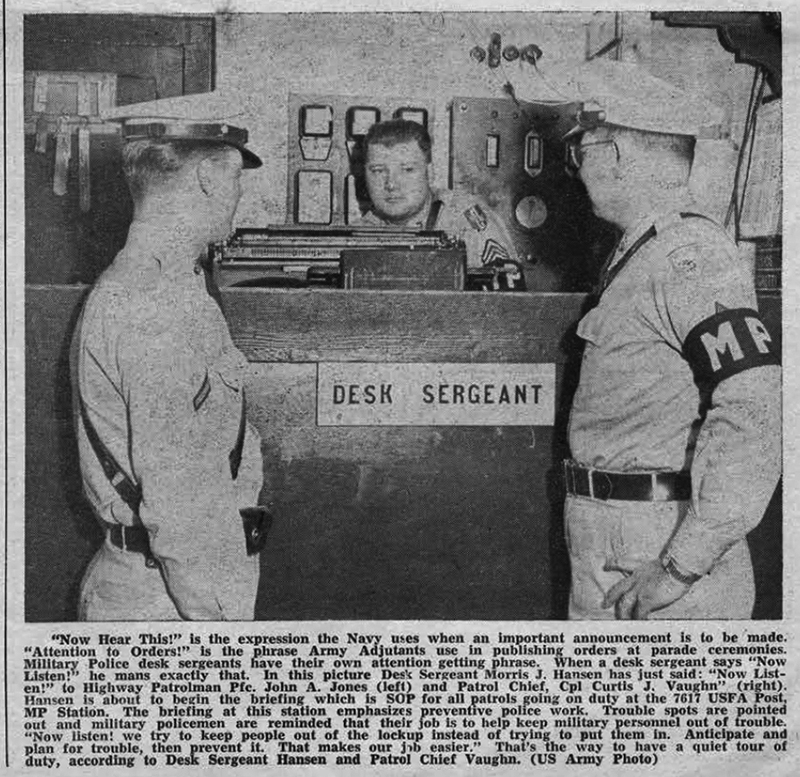 |
||||||||||||||||
| Quartermaster Petroleum Laboratory | ||||||||||||||||
| (Source: Email from Jerry Gould) | ||||||||||||||||
| Frank and his wife (Happy) and I and my wife (Betty) lived in a new apartment house on Viale Italia and Viale Nazario Sauro. Frank performed all maintenace on the Lab and vehicles -- Jeep and a Tractor to move the lab whenever needed. I received orders sending me and Betty back to the USA arriving in NYC in early March 1955. According to the web site, Camp Darby was a much smaller installation when we were there as compared to what it started to become starting in late 1955. |
||||||||||||||||
|
||||||||||||||||
| (Source: USFA SENTINEL, Aug 27, 1954) | ||||||||||||||||
| The First Quartermaster Petroleum Products Laboratory, Camp Darby, Leghorn, is losing its last member who arrived with the unit from the United States. In June 1952, Sgt. Stanley S. Kilinski was responsible to insure that the laboratory was complete and in working order before shipment overseas. He then followed the equipment to Leghorn to help assemble it and to place it into operation. Kilinski was first assigned to First Quartermaster Petroleum Products Laboratory as a lab analyst and technician, but was later given the added responsibility of consolidating and evaluating results from prescribed tests run on petroleum samples. From these results, he made recommendations for the use or disposal of the fuels and lubricants. One day in August, 1953, Kilinski was told that a stage manager was needed for the Soldier's Show Workshop Production, "Feathers in Your Hat," which was just then being written. After accepting the job, he enlisted the aid of friends, when he found that most scenery had to be built. For almost a year Kilinski spent every off-duty hour helping to produce, manage, and build scenery for three additional productions. |
||||||||||||||||
| (Source: USFA SENTINEL, Aug 27, 1954) | ||||||||||||||||
| Support Cmd's 1st QM Petroleum Product Lab insures that gas, oil and kerosene used by American armed forces meet government standards and specifications. When the laboratory first started its operation, considerable variety in quality was found in the fuel, which is purchased from Italian suppliers.Since the lab's establishment, the quality of the fuel has consistently improved, according to M/Sgt Richard A. Glenn, NCO-in-charge. Laboratory personnel are constantly touring USFA acquiring "on-the-spot" samples and checking installations operating permanent deposits of petroleum products. "Lab personnel on the road are always on the lookout for deterioration of petroleum products," says Glenn. One of the major causes of "bad" gas is water condensation. Water thus formed settles to the bottom of the large storage tanks. Laboratory personnel insure that this water is removed through pipes and pumps. Another deficiency occurs when gas is stored for long periods. The fuel loses its vapor pressure through evaporation of its light hydrocarbons. If vapor pressure falls below eight pounds per square inch, the motor in which it is used will fail to start. Also during long storage periods, gasoline tends to deteriorate because of an increase in its gum content. This is the same gum that sticks to valves and is responsible for low performance of motors. Another important test is a gravimetric analysis which determines lead content of petroleum products obtained from local producers. The percentage of lead determines the gasoline's octane rate. Gas most commonly used by USFA motorists is 86 octane. Officer-in-charge of the highly trained team of chemists and petroleum specialists is 2nd Lt Henry W. Miller, who holds a BS in petroleum engineering from the University of Houston, TX. Prior to his present assignment, Miller was administrative officer of the New York petroleum field office (QM), in Jersey City, N.J. Sergeant Glenn has been working with petroleum products for seven years. He attended the Army Petroleum School at Caven Point, N.J., for nine months. Upon graduation, Glenn worked for four months with the Standard Oil Co of New Jersey petroleum laboratory. Another member of the lab staff, Pfc Gilbert J. Sloan, holds a PhD in chemistry from the University of Michigan. Prior to entering the army he was a research chemist with DuPont DeNemours & Co. Pfc Andrew Harautuneian graduated with a BA in chemistry from Fresno (Calif.) State College. Prior to joining the Leghorn lab he completed two years of graduate work in chemistry at UCLA and UC. A third member, Pfc Robert T. Trites, with a master's degree in chemistry from Western Reserve University at Cleveland, Ohio, worked as a chemist with the Lubrizol Corporation prior to entering the service. |
||||||||||||||||
| 7618th Verona Storage Point | ||||||||||||||||
| 1954 | ||||||||||||||||
| (Source: STARS & STRIPES, Dec 22, 1954) | ||||||||||||||||
| The 7618th Verona Storage Point in Verona which is an integral part of the U.S. Forces in Austria Support Comd depot operations, has been reorganized to allow it more administrative powers.
Four officer, 12 EM and 73 Italian employes are assigned to the storage point under Lt Col Bryon I. Holly. Under the former system all personnel attached to Verona installation were under the jurisdiction of Support Comd units, which increased the command's administration and hampered the efficiency of administration and operations in Verona. |
||||||||||||||||
| 68th Military Police Company | ||||||||||||||||
| 1953 | ||||||||||||||||
| (Source: Email from Dick Baughman) | ||||||||||||||||
| As you indicated there isn't any info about Camp Darby on the website as yet. Let me offer some of my reflectings regarding the time I spent there. Arrived in Livorno, (Leghorn) on Dec 15, 1953 after spending 14 days on-board the USNS General H. F. Hodges troop ship. We were taken to Camp Darby, 7617th USFA Support Command, outside Livorno, not far from Pisa. It was there that the 588th Replacement Co. processed all new arrivals for assignment to "field forces" in Austria. Some of us were selected to remain at Darby. I was assigned to the 68th MP Co. as their communications chief, maintaining the radios installed in patrol jeeps and sedans. Duties of the 68th included camp security, guarding supply and ammo warehouses, as well as patrolling Leghorn and Pisa. Since we were considered "guests" of the Italian government, all MP's had to be accompanied by a member of the Italian Carabinieri (police). Some of my more vivid memories are of the "carnival" at Via Reggio. This is a week long celebration similar to the Mardi Gras in New Orleans. The horse race in Siena and the battle of the bridge in Pisa, where one side of the city has a team that attempts to push a team from the other side off the bridge that connects the two sides of Pisa. The losing side has their electricity turned off for one hour that night. New Years eve when the custom in Pisa is to discard all chipped or broken china and old pots and pans onto the streets at mid-night. We had to warn our patrols to stay off the streets at that time. The 1954 melli millia went by our front gate. Something to see those cars going by at 150 mph! Another memory was the time that the US pulled all our troops out of Trieste which was, at that time, another 4 power city. We, in Camp Darby had over 5000 troops, including the 350th Inf Bat (1) descend on our small camp with its 3 barbers, small PX, and 1 movie. There were tents set up on all the baseball, football and soccer fields. They went on a 24 hour training schedule, with troops marching about the camp at all times. That was the time I took a leave to get away from all that soldier activity. For Ron Homer, I have to mention the Thanksgiving Day football game between Camp Darby and the 11th AAA. I don't remember who won? Well, that should do it for now. If there is anyone out there that was at Darby and would like to compare experiences, shoot me an e-mail. Units at Leghorn at that time included: 7617th Support Command- APO 19 21st Signal Co 28th Station Hospital 550th Eng Co (Depot) 68th MP Co. There was also a WAC company. (1) Webmaster note: The 351st Infantry Regiment was stationed at Trieste and was the outfit that was moved to Leghorn when the US pulled out of Trieste. |
||||||||||||||||
| Related Links: | ||||||||||||||||
|
||||||||||||||||
